Our thanks for this guest blog go to Meredith Smith, Paediatric Physiotherapist and Lecturer in Physiotherapy in the School of Allied Health Science and Practice at the University of Adelaide. In this blog, Meredith talks about the development of a Talking Mats resource to facilitate self-reporting in pain assessments for children and young people with cerebral palsy.
Our research team has been working on modifying pain assessment tools so they are more appropriate, relevant and accessible to children and young people with cerebral palsy (CP). People with CP have varying functional, communication and cognitive abilities, which makes existing assessment tools (often pen and paper questionnaires) difficult to use across the spectrum of ability. As a result, children and young people with CP often don’t have the opportunity to self-report how pain is impacting their function.
We are based in Australia and our team is made up of physiotherapists, an occupational therapist, a medical practitioner, researchers and people with lived experience of CP. One of the first things we did as part of this project was to ask people with lived experience of CP and clinicians what we could do to make two specific pain assessment tools more accessible and relevant to people with CP and different abilities. One of the clinicians (a speech pathologist), suggested we consider a Talking Mat alternative for each of the assessment tools. These two assessments focused on two concepts – 1) how pain interferes with function and 2) pain-related fear. We were keen to focus on these assessments as this would help us to not only open up a conversation about pain with children and young people with CP, but would also provide us with a way of identifying children who might benefit from particular pain interventions, and allow us to monitor the effectiveness of these interventions.
Prior to this suggestion I had heard of Talking Mats but never used it. Our research team underwent Talking Mats foundation training which was excellent, and we were all really impressed with the concept and its application in varying contexts. We had initially thought that we might need a Talking Mat to get feedback from children on the assessment tools, but we all agreed that converting the pain assessment itself into a Talking Mat would make the most sense for now.
Working with the Talking Mats team was a fantastic experience. We all really appreciated the expertise of the consultants in considering how we worded some of the assessment tool items. The symbols created were also excellent, and when we tested them with children and young people with CP they were simple and easy to understand.
Here is an example of a Talking Mat discussing pain interference with function. The lead in phrase is ‘how much does pain get in the way of……’. This Talking Mat was easily understood by most children with CP, even those with moderate cognitive impairment and complex communication needs.
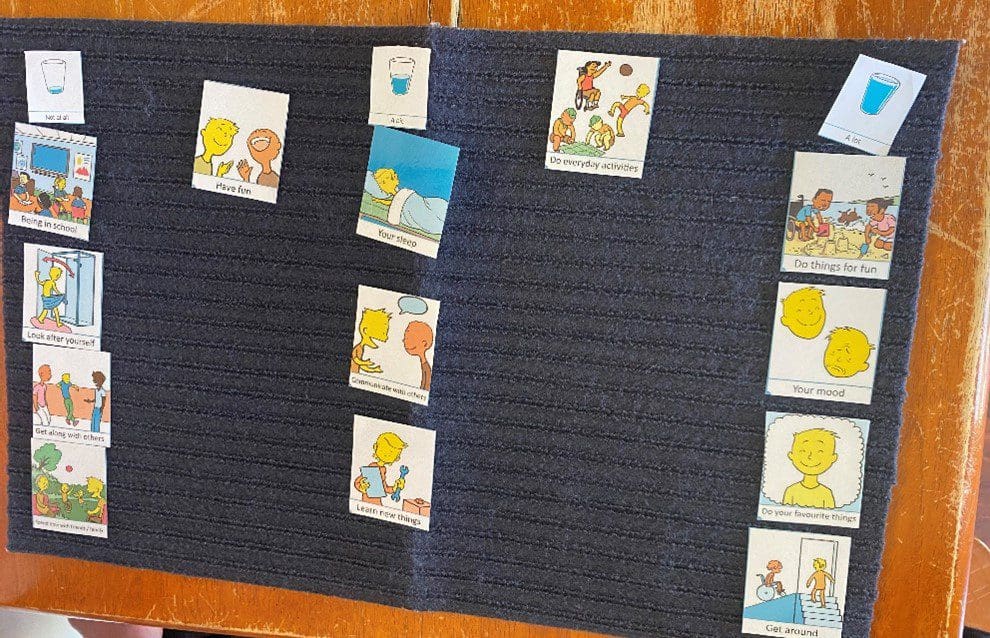
The second Talking Mat looked at pain related fear, with the lead in phrase ‘pain makes me……’. This was a more challenging and abstract concept, but was much easier to explore using the mat than on a standard pen and paper questionnaire. The Talking Mat versions can be interpreted as a 5-point response scale (the three response options and then two in-between sections), allowing us to still total an overall score for the assessment.
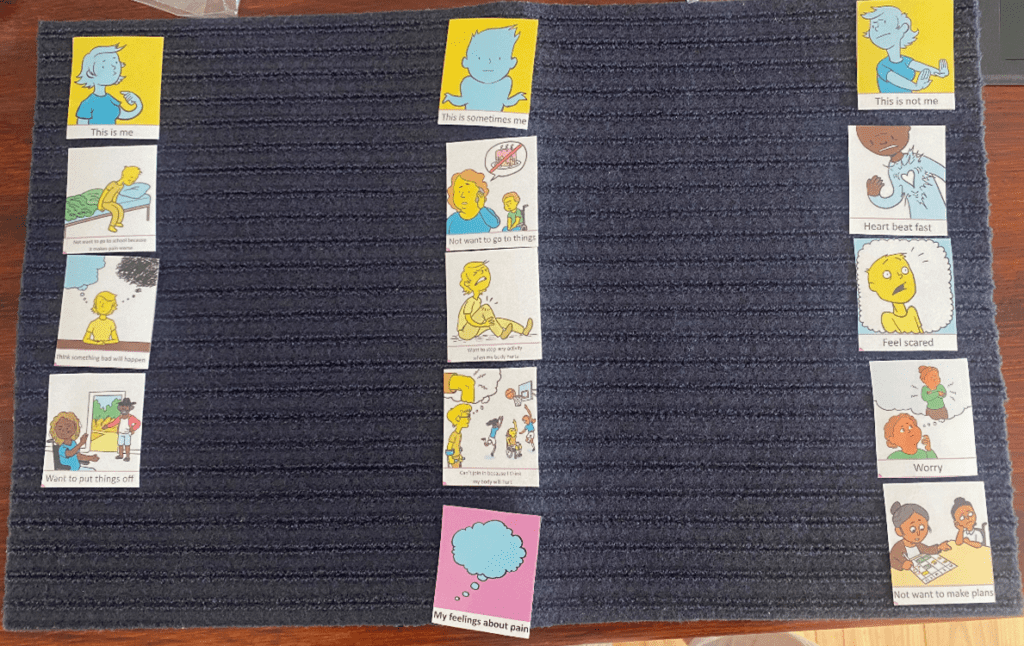
The feedback from children, young people and their families has been very positive. Families of children with cognitive impairment or complex communication needs have shared with us that previously it was assumed that their child could not self-report pain, and often they were asked to proxy-report on their behalf. Parents have told us how difficult it is to proxy-report on personal concepts such as pain-related fear, and that they couldn’t possibly know for certain how pain was making their child feel.
We are in the process of continuing to test the Talking Mats resource and look forward to making the it more widely available in the future.
Keep an eye on our website for more information about the Pain Assessment Resource as this project progresses.
If you are interested in completing Talking Mats Foundation Training, you can find out more here.
Talking about sensitive issues can be challenging at times. We are so excited to publish this guest blog from Julia Pollock, Highly Specialist Speech and Language Therapist (SLT) from the REACH team in Perth, Scotland, explaining how a newly developed Talking Mats resource helps to open up conversations with young people about sex.
REACH is a unique team, one of a kind in Scotland, that provides intensive support for care experienced children and young people on the edge of care in Perth & Kinross. We are a multidisciplinary team bringing together professionals across health, education, social work and youth work. This allows us to provide prompt specialist care, while limiting the need for referrals to multiple agencies.
My colleague, Janie Scott, and I have worked for REACH since its inception, as Highly Specialist Speech and Language Therapists. Research shows that more than 60% of care experienced young people have some kind of speech, language and communication need (SLCN) and at REACH we work on the assumption that our young people may have an SLCN – until proven otherwise. This means that we routinely offer communication assessments and support to every single young person (and their parent/carers), in addition to keeping inclusive communication at the heart of everything we do. Adopting this approach ensures that none of our young people have to struggle with communication difficulties unsupported.
Working in a multidisciplinary team with a heavy social work contingent has been a very different experience for Janie and I. The team were open to our training and approaches and allowed us the freedom and autonomy to shape our own SLT service.
One of the first things we did at REACH was to introduce Talking Mats. We are both Talking Mats Licensed Trainers. All our REACH staff, as well as any other colleagues across the council and NHS who also work with our young people are Talking Mats trained.
Despite some initial scepticism around using pictures with teenagers, the resource has since proven to be incredibly useful and engaging for this particular client group. It has now become a staple resource that our staff will reach for regularly to facilitate conversations with our Young People and to help them express their views on complex issues.
Our young people can occasionally find themselves in conflict with the law and wrapped up in the complexities of the criminal justice system, as a result of their often disadvantaged backgrounds, and/or due to a range of ongoing challenges such as developmental trauma, social emotional and mental health difficulties, and/or Speech, Language and Communication Needs (SLCN). In addition to supporting REACH clients through their criminal justice journey, our team also specialise in harmful sexual behaviour assessments, for both internal and external clients.
The idea for a Talking Mats resource for harmful sexual behaviour initially came from one of our Senior Practitioner Social Workers, Amy MacKinnon, who suggested that Talking Mats might be a useful tool to support their harmful sexual behaviour assessments (AIM3). The assessment, which involves interviewing the young person about incredibly sensitive and personal issues, can be quite confronting for young people. We discussed the possibility of having visual resources which would not only cater to the SLCN of our clients, but that would also make the assessment feel less intimidating for the young people, encouraging more open and honest responses.
We often start by assessing a young person’s existing level of sexual knowledge and understanding, as how can young people possibly share their version of events if they do not understand the basic concepts of which they were being accused of?
This includes exploring their understanding of the language around sexual physiology and anatomy, in addition to the social and legal considerations of sexual behaviour. The introduction of this resource allowed us to explore existing knowledge much more effectively than we had previously, with a more logical progression of concepts ranging from the very concrete language for body parts, through to more abstract ideas such as consent. More careful consideration of the young person’s language level really helps to ensure that the Young Person’s responses are accurate. We recognised that our existing pictures/resources needed development and so I approached Talking Mats to ask if they would consider working with us to create an official Talking Mats resource using their own artwork and branding. I know from experience that their artist, Adam, always does a fantastic job creating simple images that are so easily understood while also being sensitive and inclusive.
We developed a small working group with a handful of REACH and Talking Mats staff who have focused on developing a new healthy relationships resource to open up these tricky conversations. We have now completed the pilot stage, and have a fantastic resource. Talking Mats did not disappoint and as expected, they worked wonders with the images!
One interesting development along the way was the group’s reflection that the resource had felt quite negative and that perhaps we should keep a more neutral stance when developing the concepts – leaving room for much more general (or even positive) discussions around sexual development too. This allowed us to expand the resource to include concepts relating to puberty and gender identity. We felt that this would make the resource more far-reaching and impactful, while still retaining the option to use the more niche resources for addressing harmful sexual behaviour, when required.
The feedback we have received has been overwhelmingly positive, with comments such as ‘It’s amazing’ and ‘We’ve been sitting waiting for a resource like this.’ Those trialling the resource for us unanimously felt that the resource helped them to discuss the topic with their clients, helping to ‘open up’ discussions that would otherwise be more challenging to initiate. We have also received a lot of positive feedback on the clarity of the concepts and images; the consensus being that the visuals are easy to understand and unambiguous. This is fantastic feedback given the complex and abstract concepts we were tackling with this resource!
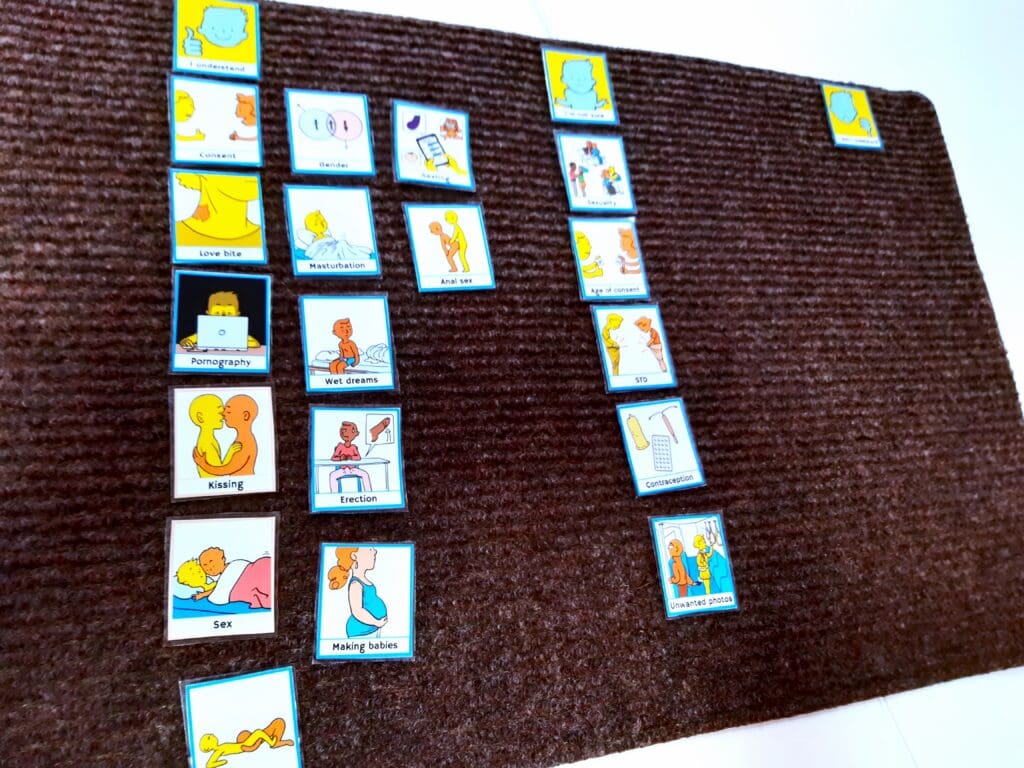
We are looking forward to sharing more information about the project and resource in an Advanced Webinar for practitioners who have already completed Talking Mats Foundation Training, in September 2024.
Look out for the second part of Julia’s blog next week, to read one of the powerful examples of the positive impact this resource has already had.
Inspired to think about Talking Mats Foundation Training? Find out about all the options we have available here.
This year’s campaign focuses on the importance of all children and young people whoever they are, and wherever they are in the world, to be able to say – and believe – “My Voice Matters.” Talking Mats is a tool that allows the voice of the young person to be heard. Read these blogs on Mental Health and Young People to find out more.
- Dr Carla Innes, Clinical Psychologist for Learning Disabilities at Stockport Healthy Young Minds (CAMHS) describes how Talking Mats helps the team to gain more insight to the children and young people they are working with, and how it has helped intervention focus on the child’s potential, and zone of proximal development.
- This work in Stockport is further expanded on in a presentation by Dr Rosie Noyce, Clinical Psychologist, given at the Talking Mats 21st Birthday Event in August 2019.
- Sally Kedge, SLT with Talking Trouble, New Zealand shares 2 powerful case examples of using Talking Mats with children and families caught up in the Criminal Justice System and demonstrates how the connection with a therapist can be the key to unlocking feelings and emotions
- Natalie Paris, Project Lead for Cashback180 programme based within Mayfield and Easthouses Youth 2000 Project, shares stories of using Talking Mats with young people in Midlothian.
- Our Director, Margo MacKay, describes using Talking Mats to ask young people about their environment and the impact different environments can have on wellbeing.
- Laura Holmes, our Lead Associate for Children and Young People, writes about the Virtual Schools Team in Wigan and how they used Talking Mats with Looked After Children.
To find out more about Talking Mats Foundation Training for you or your organisation, click here.
Communication is a fundamental human right, yet many individuals with communication difficulties face daily challenges in expressing their thoughts, needs and feelings. Augmentative and Alternative Communication (AAC) is a powerful tool that bridges this communication gap, and Talking Mats is one innovative approach that has proven highly effective in enhancing the lives of those who use AAC.
However, in the 25 years that Talking Mats has been developing resources we have never created one that specifically addresses the needs of AAC users.
Until now!
The new resource, Supporting Communication with AAC and the online advanced training module, AAC will be launched at this year’s Communication Matters Conference 9th-11th September.
The idea
Ace Centre first contacted us in 2018 with the idea of developing a specific assessment resource that would allow the person considering using AAC to express their views about it; were they ready to use AAC, did it fit with their life and communication needs and how much support would be required? This could then inform decisions around referrals onto specialist AAC services.
Development
As with all Talking Mats resources, this one was piloted and discussed and changed until the final version was reached. Thank you to all the practitioners and clients who gave their time and energy in that process. Thank you also to the Scottish Centre of Technology for the Communication Impaired who also collaborated on the resource and the module.
Outcome
The outcome is a resource that can contribute to both assessments and reviews, and an Advanced online training module, both of which aim to put the AAC user at the heart of decision making about their communication.
Here is a brief outline of the resource and the module.
Supporting Communication with AAC (card and digital resource)
Topics
Your Communication
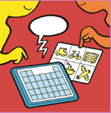
This topic considers the ‘How’, ‘Who’ and ‘Where’ of interactions and helps develop an understanding of the Thinkers communication needs. It can be completed when you are getting to know the Thinker.
Joining in conversations

These topics are designed to help a Thinker explore how they feel about their AAC resource when it comes to joining in conversations and reflect the fact that an individual often uses a combination of communication modes to be effective. The three topic cards are: Verbal conversation, Paper support and Electronic Support.
How your AAC works
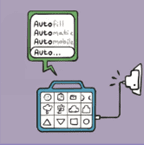
This topics explores different ways of accessing the AAC device as well as the different features it has, incluing functions, appearance, sound, and access.
If you are trained in Talking Mats to Foundation level you can buy the resource from our website
AAC Advanced module
To access this course you must have already completed the Foundation Course.
The objective of this course is to ensure that AAC users are at the heart of decision making and that necessary adaptations are in place to support those conversations
The course is split into three different sections:
The Resource
Aim – to recognise the different topics and who they might be suitable for
Access
Aim – to recognise different positions, places and methods for a Thinker to access a Talking Mat
Communication Dynamics
Aim – to recognise the dynamics in a conversation, and appraise the process of using additional people during a Talking Mat
To successfully complete the course participants must pass the quiz and contribute to the forum telling us about their experience.
Courses will run from the 1st of every month starting in November.
Talking Mats: developed in Scotland, embraced world wide with close working relationships in Japan, Sweden, Australia and New Zealand, but can the framework be adapted to reflect different approaches to communication that these diverse cultures embody? Victoria Mardell’s discoveries offer a fascinating insight into differences between Western communication and that of the Māori culture showing that the Talking Mats framework can be a cross culture communication tool.
Using Talking Mats in Te Ao Māori (The Māori World)
A Non-Māori SLT’s collaborative journey to deeper understand whether the Talking Mats process is culturally responsive to Māori
My Project
Working for the Aotearoa New Zealand Ministry of Education, I was approved to undertake a project which would investigate the suitability of Talking Mats to capture child voice.
A key part of this project was to review whether Talking Mats were culturally responsive to Māori and reflective of Māori worldview and if not, whether they could be altered accordingly.
This led to a rewarding journey for me as a non-Māori practitioner as I was able to collaborate with Māori colleagues and improve my cultural awareness. I got to experience Māori ways of gathering and acquiring information and I came away with new perspectives, which have shaped my practice.
Information Gathering: Learning About and Holding a Wānanga
To gather the information needed, it was suggested that I hold a wānanga. The word ‘wānanga’ would loosely translate as a “forum” in English. However, a more accurate description would be a collaborative process which involves engaging, sharing, and reflecting, with space for all viewpoints. A wānanga would often lead to the creation of new knowledge and decision-making.
This was my first experience with a wānanga and whereas Western ways of acquiring knowledge would likely have placed myself as an “expert”, seeking “feedback”, the wānanga was an unhurried deep discussion, in which all participants were partners, collaborating on an important subject.
Findings
There was overall agreement that Talking Mats are a good fit with Te Ao Māori.
Talking Mats were seen as a good way to promote Mana Motuhake (self-determination) and whakamana (giving prestige to children and their families).
Te Ao Māori (the Māori worldview) is strengths-based and the wānanga participants thought Talking Mats was a good fit with this approach.
Some considerations were discussed:
Codesigning the top scale: Participants discussed that concepts such as “going well” “not going well” are Western and that if a Talking Mat was used in a Māori kura (school), or with a Māori whanau (family), then categories might need to be adjusted or changed. This could be done via discussion and collaboration.
Māori colleagues have also shared some ideas with me for potentially suitable top scales:
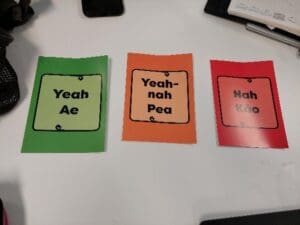
(Sonja Macfarlane, 2021)
The key point was the importance of collaborating on the top scale rather than having this pre-determined before delivering the Talking Mat.
Being mindful about predetermination: Participants discussed how a practitioner turning up with a Talking Mat and a set of visuals might be seen as pre-determination and this could lead to discomfort and resistance. It would be more helpful if the practitioner facilitated a discussion, with the use of drawing visuals ‘on the fly’ as well as using the Talking Mats visuals. In practice this could look like a more collaborative process, with a greater input from the thinker in the early stage of the mat, rather than just at the end.
Action points may be strength-based rather than deficit-focussed: We discussed how there is a tendency in Western thinking to set goals or action points around improving things which the thinker has identified as not going well. However, in keeping with a Māori worldview, actions points might be to do more of what you already like, or to mentor others. We need to be careful that as practitioners, our unconscious bias is not inadvertently encouraging the thinker to focus on areas they have rated negatively.
Practice Example and Changes to my Practice
During the wānanga my former colleague, a Māori SLT, shared an example of a Talking Mat she had done about how a student wanted to participate in kapa haka (group performance of Māori dancing and chanting).
The SLT created her own visuals to reflect the kapa haka process. During conversation the SLT and student discussed how she could fatigue easily so the SLT drew an option to sit or stand. The action point was for the student to participate in waiata a-ringa (action song), with an option to sit if fatigued.
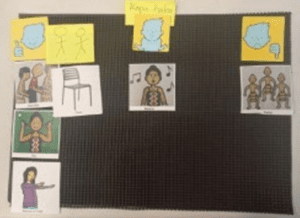
The process of considering Talking Mats through a Te Ao Māori perspective has changed my practice and I am grateful to my Māori colleagues for their time and insights. I am now more mindful when reviewing a Talking Mat, to make sure the action points are coming authentically from the thinker. I am also a lot more collaborative in the visuals and top scale of the Talking Mat. I have found that practising with more collaboration has led to better relationship building and more in-depth conversations.
Mauri Ora
Thank you to Victoria for her work on this blog. If you have any questions about this please contact us on info@talkingmats.com
Question: What is a Talking Mat?
Answer: Talking Mats is a visual communication framework which supports people with communication difficulties to express their feelings and views.
That’s what our website says in black and white and you wouldn’t be alone in thinking it actively excludes people with a visual impairment. However, one of our Licenced Trainers and Speech and Language Therapist, Olivia Ince recently got in touch to share a story of a creative and innovative approach to using the tool; a Braille Talking Mat.
The mat was facilitated by an Outreach worker for Children with disabilities (the listener) who had been trained in Talking Mats by Olivia. The young person sharing their opinions (the thinker) has a genetic neurodegenerative disease which affects the nervous system, causing progressive difficulties with physical and cognitive skills including communication impairment and vision loss. The Outreach worker and Olivia worked on the project together.
Trialling a Braille Talking Mat
We have been working together on a project to trial a Braille version of a Talking Mat. Talking Mats is a visual tool, but we knew that a Braille version could work in theory if some adaptations were made and if the thinker had the cognitive ability to understand the Talking Mats process.
We thought a Talking Mat would be a good approach for this young person because it could help to make the conversation more engaging and create a more balanced interaction than asking a long list of questions. For this young person, the Talking Mat was primarily a thinking tool.
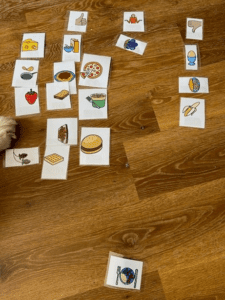
Introduction:
We started the process by introducing a concrete, familiar topic; food with the topscale of ‘like/ don’t know / don’t like. Using a concrete topic like food meant that the listener could discuss the responses with the young person’s wider network and find out if the mat was a true reflection of food preferences, thus giving further insight into the young person’s understanding of the Talking Mats process.
Adaptations:
The support team had access to a Braille machine which meant that a Braille sticker could be added to each laminated symbol card in the Talking Mat. Having both Braille and symbols on the cards meant that the Talking Mat was meaningful to the thinker and the thinker’s network, as a photo could still be taken as a record and to allow any actions to be followed up.
As usual, the listener handed the card to the thinker which allowed them to read the Braille.
- After reading each option card, the thinker then passed the card back to the listener and told the listener where to place each one under the top scale.
- At the end, the listener asked the thinker if they would like to read the Braille on all the cards again as part of the review and reflect. The thinker did not wish to do this, so the listener verbally reviewed the Talking Mat for the thinker.
We considered the alternative approach of guiding the thinker’s hand across the top scale allowing them to read the Braille after having read the Braille on each option card. The thinker could then have placed each option card under the top scale with some hand over hand guidance, but this was decided against due to the increased physicality and cognitive load of this additional action for the thinker.
Reflections:
When the Talking Mat was initially discussed the young person expressed curiosity about what it was and how it worked. Throughout the session they appeared to feel involved, enjoying the tactile and interactive nature of the Talking Mat process, increasing engagement with the process.
The Talking Mat helped the thinker to share their views on a wider variety and greater number of options than what would have been possible in a verbal conversation on the same topic. The Talking Mat also facilitated a more structured, empowering and accessible interaction for the thinker and created the time and space for them to share their views.
Now that this trial Braille Talking Mat has demonstrated that the thinker can engage in the Talking Mat process from start to finish and that they seemed to enjoy sharing their views using this tool, in future further Talking Mats could be used to help the thinker share their views on more abstract, emotive topics.
Overall, this project has shown that a Braille version of a Talking Mat can successfully support people who have a visual impairment to share their views.
If you would like to find out more please contact us on info@talkingmats.com and questions can be passed onto Olivia.
Over the past few years Cornerstone and Talking Mats have been developing a resource to allow anyone using their services to be more involved in recruiting their own support staff enabling them to express what personal qualities, skills/knowledge and behaviours are important to them.
Why was there a need for this resource?
Colleagues Kerri Bellingham (Recruitment coordinator) and Debbie Masson (HR Projects and Research Advisor) knew involvement was a big part of their organisational ethos but believed they ‘could do it even better’.
This together with feedback from a person supported by Scottish organisation Cornerstone prompted two team members to re-examine the process of recruitment and how everyone can be more involved
Scottish Charity Cornerstone has been providing care and support for people with learning disabilities, autism and complex care needs across Scotland for over 40 years. The Organisation prides itself on putting the people it supports at the heart of service delivery. There is a strong ethos of offering choice and control ensuring care and support is person-centred.
Kerri and Debbie set out to create an approach that would directly reflect the National Involvement Network Charter;
“We want to be involved in choosing the people who support us. This includes our support worker, key worker, managers and other staff, volunteers and our advocates. This means we must have the choice to be involved in; writing job descriptions and person specifications, planning interview questions, taking part in interviews and deciding who gets the job”
(NIN Charter, statement 5)
The aims for the recruitment resource were for people supported by Cornerstone to;
- be more involved in recruiting their own staff if they want to be
- be given the freedom and ability using these tools to express what values, skills and behaviours are important to them, and feel they are being listened to
- gain new skills and increase their confidence
- develop a ‘best-match’ approach that would identify ideal candidates suited to an individual’s support needs, preferences and interests with a view to improving outcomes and continuity of care
Providing a way for the supported person to communicate their opinions is where Talking Mats came in.
Development
Development of any new Talking Mats resource requires research and careful planning. A focus group was held with people who received services from Cornerstone and the staff that supported them. There was a lot of discussion about what would be a given, for example, being kind, caring or compassionate as well as other key attributes. A lot of flip chart paper was used but the group was happy with the structure agreed on.
The 3 topics agreed on were:
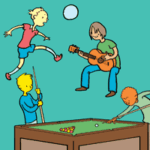
Interests
This topic asks the thinker (the person supported) to consider their interests and the activities they enjoy, or goals they would like to achieve, so these can be considered in the matching process. These requirements can then form part of the role profile and / or also inform the interview questions.
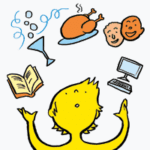
Skills / Knowledge
Again, this allows for appropriate description of role, for example noting if driving skills are required, would competence and knowledge of technology be helpful , or have they a good understanding of the local community so socialising or networking can be promoted and local activities or opportunities maximised?
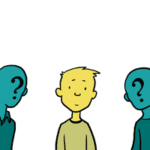
Type of Person
This topic can also contribute to a Person Specification but the concepts are more abstract, and the thinker considers what attributes in a potential support worker are important to them.
Kerri, Debbie and everyone involved in the project believe this tool will “enable us to more closely match the people we support with their ideal member of staff whilst ensuring they have a pivotal role in the process”.
Cornerstone are looking for Organisations to help them trial this new resource. If you are interested and are an organisation who provide residential or day care and want to involve service users in
- recruitment and /or
2. reviewing their care package and give feedback on their staff
then please get in touch by the 21st of July. We will send you the resource and in return we ask that you use it at least 2 times between now and October provide feedback. Please contact paula@talkingmats.com
It’s that time of year; the days are longer, there are lambs in the fields, the grass is getting cut and people are thinking about new beginnings. Maybe you want to embrace the Spring momentum and get a new skill under your belt, the one you’ve been hearing about from colleagues and reading about on social media; Talking Mats!
Talking Mats has been busy and there are new resources about to be launched but they have the line ‘only available to those trained in Talking Mats’. You attended something a few years ago and you think something was said that had something to do with Talking Mats – does that count? And it’s just pictures how hard can it be?
If this sounds like a conversation you’ve had with yourself read this blog to find out why training in this innovative communication tool is recommended.
I need this training; how can I get it?
You’ve made the decision that you’ll get trained in Talking Mats. What options are there to let you do this? Like all training providers over the last 3 years Talking Mats has had to adapt our training provisions. We have also had to be responsive to what our customers want; there is a much bigger demand for virtual training and online training than we experienced pre 2020. To reflect this we currently offer a variety of ways you can access our Foundation Training. Your choice will depend on the answers to several questions; what sort of learner are you? Can you do this as part of your working day or will it be in your own time? Can you apply for study leave? Following from that; would you like to buy a resource with your training and what is available ? The following diagrams should help simplify things and more in depth information about Foundation Training is on our website, as well as booking information. Being trained in Talking Mats allows you to access all our Advanced Courses and Resources and go on to become a Licenced Trainer.
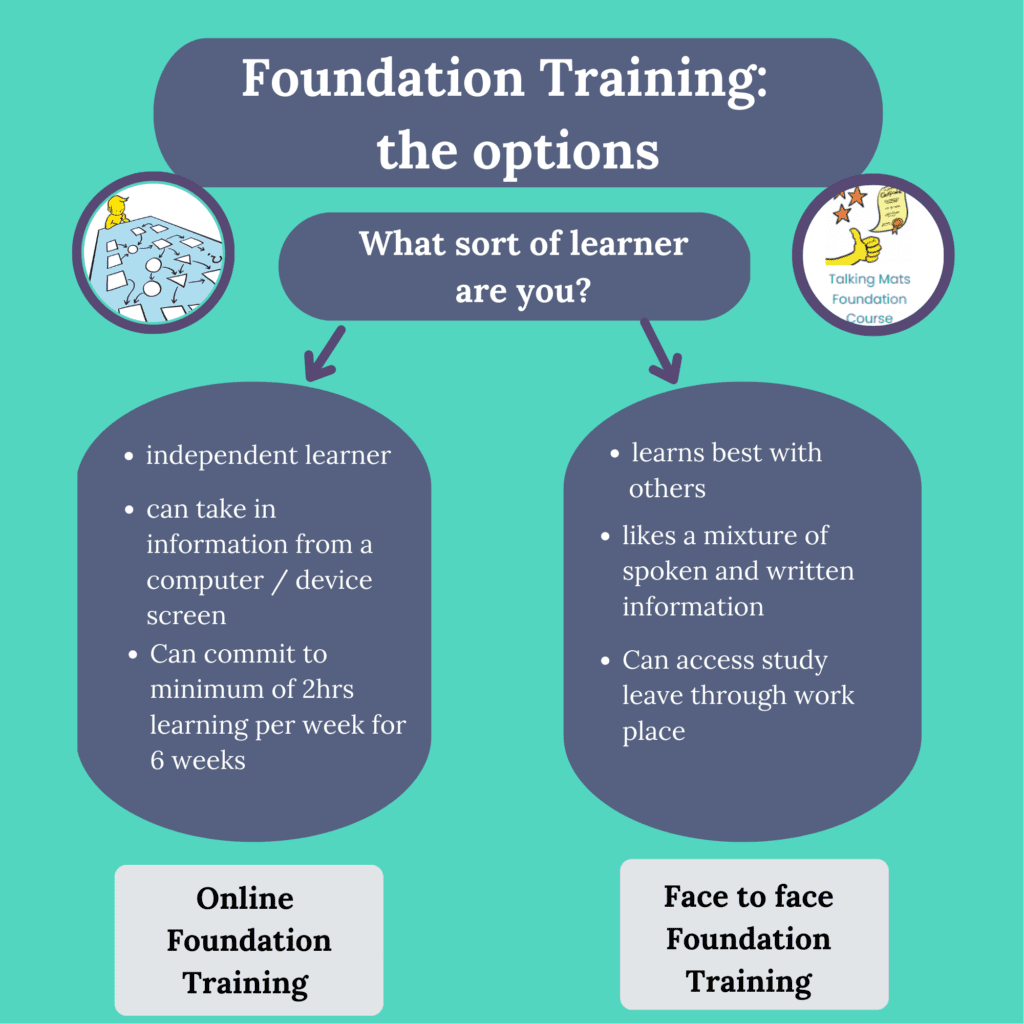

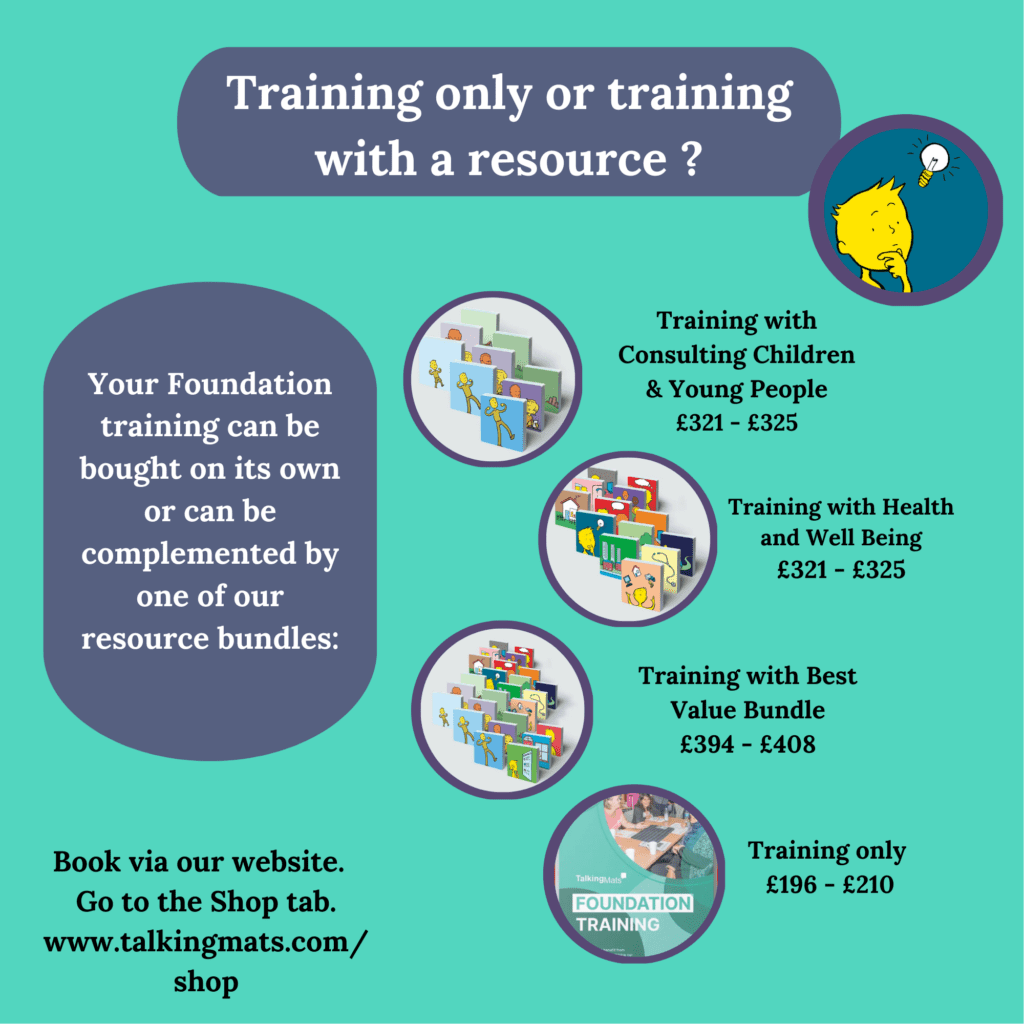
Thank you to Lisa Chapman,Lead Speech and Language Therapist at Bee U: Child & Adolescent Mental Health Services, Midlands Partnership NHS Foundation Trust, who has shared her thoughts about the new sensory resource, sharing what it means to her both professionally and personally. Use these links to read more about the resource and our giveaway offer and to book directly.
A personal and professional journey intertwined.
Communication has always been one of my passions. As a languages teacher I was struck by the speech, language and communication needs (SLCN) of my students and this led me to retrain as a Speech and Language Therapist (SLT). As a parent I saw how my youngest son struggled to communicate his needs and how others struggled to understand him across different environments. He now has a diagnosis of Autism and the experiences we have had together were the start of my journey to explore Sensory Processing.
Sensory Processing, Sensory Integration and Neurodiversity.
Sensory processing is something we all do, it is how we make sense of the world around us using our 8 senses. These websites offer a good general overview of our senses and sensory processing;
- Understanding Sensory Processing and Integration in Children (sensoryintegrationeducation.com)
- Free online sensory processing course for teachers, assistants and parents (griffinot.com)
How this information is then dealt with is referred to as ‘Sensory Integration’; ‘the processing, integration and organisation of sensory information from the body and the environment’ (Schaaf & Mailloux, 2015, p5).
From my growing personal interest came ideas on how sensory processing and integration overlapped with my professional life as an SLT. Hooked, I enrolled on the Sensory Integration Masters course with Ulster and latterly Sheffield Hallam University. I completed my Diploma in 2021 and hope to complete my Masters dissertation later this year.
I love that I have been able to weave my ‘lived’ experiences into my professional development. These experiences continue to overlap. Most recently, this has involved exploring the concept of Neurodiversity, “the infinite variation in neurocognitive functioning within our species” (Walker, 2014a). Walker clarifies that the neurodiversity paradigm has three fundamental principles
• Neurodiversity is natural and valuable. We are stronger because of our diversity.
• There is no one ‘right’ way to process information. There is no such thing as a ‘normal’ brain.
• It is important to acknowledge social power dynamics exist in relationship to diversity. Walker (2014b) reminds us to ‘check’ our privilege. This will frequently involve moving out of our comfort zone (Murphy, 2022).
This paradigm has become a core framework for me as both an SLT and a parent. It helps me make sense of variations in communication and sensory experience, to reframe these as differences, not deficits. Understanding my son’s sensory processing has helped me see the world through his eyes allowing new spaces for communication and different conversations. It has helped to reduce the Double Empathy gap (Milton, 2012).
I am equally aware of the impact of environments. Luke Beardon’s (2017) ‘golden equation’, one I quote often, aptly summarises this. “Autism + Environment = Outcome”. Environment here includes identity, the sensory environment, other people and society (Beardon, 2022). The value of having a clearer understanding of your identity and needs is also context dependent, ‘relational’ (Chapman, 2021). You, and others around you, may have great insight into how your body and mind work, but this can only go so far. If no one is listening to you, and environments in their broadest terms are set up to be against you, are ‘low-functioning’ (Patten, 2022, p.8), it is harder to achieve positive and authentic outcomes.
For my autistic son, education settings have sadly often been ‘low-functioning’ environments, placing an immense toll on his sensory processing, communication and ultimately on his emotional well-being. The impact on us as parents has been no less challenging, coping with multiple exclusions from multiple placements. I have equally seen the power of restorative, ‘high-functioning’ environments (Patten, 2022, p.12) that enable him to be the best he can be: environments that offer success, building on his interests and abilities.
The very nature of neurodiversity suggests that we all process sensory information differently. A better understanding of individual sensory experiences gives more information that we can use to create and advocate for ‘high functioning’ environments for everyone, and achieve equity. A crucial first step in neurodiversity affirming practice is respecting an individual’s ‘epistemic authority’ (Chapman & Botha, 2022). To listen without prejudice, and not to enforce that we know best, just because of our position.
With this as my personal and professional ‘framework’ I welcomed the opportunity to trial the Talking Mats resource; Me and My Senses and my final thoughts are around using it with my son.
My personal journey continues; learning and growing
As his mum, and as an informed professional, I felt that I already knew my son’s sensory profile, that I could predict what some of his answers were going to be. He had also already had a full OT-ASI assessment. I came to this as an exercise in ironing out snags, not primarily one of personal learning. I couldn’t have been more surprised by the wealth of new information I came away with, after using the mat with him.

My most important learning was around the significance of smell for my son. Using the mat gave him the space and opportunity to share his insights into smell that I had never really appreciated before. What’s more, this ‘opening up’ extended beyond the time we were using the mat. For the rest of the day he continued to refer to his mat, adding further examples and anecdotes about ‘smell’ as a fundamental sense for his well-being. The mat had provided a safe space for exploration, connection and communication beyond its physical presence. It was a humbling, but also precious experience. It illustrated beyond doubt the importance of listening, but also the immense privilege of opening up and sharing a space that facilitated my son’s voice to be heard.
Until now, few tools have captured the lived ‘sensory’ experiences of children and young people. The Talking Mats ‘Me and My Senses Resource’ meets this need. It places an individual’s voice as central, acknowledging and facilitating autonomy and agency. As such, it is an invaluable tool to anyone wishing to explore sensory processing in a neurodiversity affirming way.
References
Beardon, L., (2017, July). How can unhappy autistic children be supported to become happy autistic adults? https://blogs.shu.ac.uk/autism/files/2017/07/How-can-unhappy-autistic-children-be-supported.pptx
Beardon, L. [@SheffieldLuke]. (2022, December 11). Autism + environment = outcome; environment could include: autistic self (e.g. understanding of self); others in that environment; the sensory. [Tweet]. Twitter. https://twitter.com/SheffieldLuke/status/1601894447721111552?s=20&t=HmyywdI4gDSrDJ1BggtF3w
Chapman, R. (2021). Neurodiversity and the Social Ecology of Mental Functions. Perspectives on Psychological Science, 16(6), 1360–1372. https://doi.org/10.1177/1745691620959833
Chapman, R., & Botha, M. (2022). Neurodivergence-informed therapy. Developmental Medicine Child Neurololgy. 00: 1– 8. https://doi.org/10.1111/dmcn.15384
Milton, D. E. M. (2012). On the ontological status of autism: The “double empathy problem”. Disability & Society, 27(6), 883-887. https://doi.org/10.1080/09687599.2012.710008.
Murphy, K. (2022). Neurodiversity in the Early Years. Neurodiversity & ableism reflection tool. https://assets-global.website-files.com/5f903cbab2ae71f26cf02400/638a04bcc5a15c6fda2c02b1_AUDIT_Kerry%20Murphy.pdf
Patten, K. K. (2022). Eleanor Clarke Slagle Lecture—Finding our strengths: recognizing professional bias and interrogating systems. American Journal of Occupational Therapy, 76, 7606150010. https://doi.org/10.5014/ajot.2022.076603
Schaaf, R.C. & Mailloux, Z. (2015). Clinician’s guide for implementing Ayre’s sensory integration: Promoting participation for children with autism. American Occupational Therapy Association: Incorporated.
Walker, N. (2014a). Neuroqueer: The writings of Dr. Nick Walker. Neurodiversity: Some basic terms & definitions. https://neuroqueer.com/neurodiversity-terms-and-definitions/
Walker, N. (2014b). Neuroqueer: The writings of Dr. Nick Walker. Neurotypical psychotherapists & autistic clients. https://neuroqueer.com/neurotypical-psychotherapists-and-autistic-clients/
After many months of work the new Talking Mats sensory resource; Me and My Senses is reaching the final phase and registrations open on Friday 31st March for our launch seminar. This blog gives an overview of what’s in the resource and our guest blog to be published on Friday is a powerful story of professional and personal learning with ‘Me and my senses’ playing a pivotal role.
The resource will aim to enable children and young people who have speech, language and communication needs (SLCN) and sensory integration difficulties to have a voice in their therapy assessment, planning and intervention. To find out more about the funding and development for this project please read the earlier blog here. It is also aimed at supporting all practitioners, regardless of their level of sensory integration training, to gain an individual’s voice of their ‘lived’ sensory experiences, needs and challenges.
It is divided into the following topics:
- My Spaces & Things I Do
- My Senses 1: Proprioception & Interoception
- My Senses 2: Vestibular
- My Senses 3: Taste, Smell, Hearing, Seeing, Touch
Use of the resource may contribute to sensory integration evaluation but does not replace a full sensory integration assessment, however it may equally work as a stand alone-tool. We hope that professionals from healthcare,education, in both mainstream and specialist settings, as well as colleagues in social care will value this resource.
Talking Mats is hosting an online seminar to introduce the resource and we have 50 sets to give away for free to the first 50 people who register for the seminar and are already Talking Mats trained. Registrations open on Friday.
 Online training login
Online training login 



